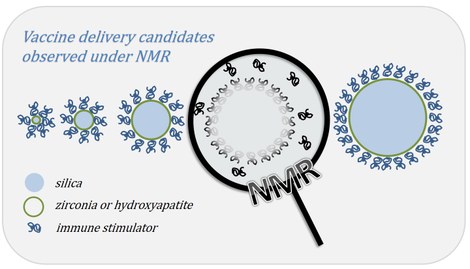Marie Skłodowska-Curie Action IF NMR4Nanos
H2020 MSCA IF 2015 Standard EF
“NMR4Nanos - Development and application of NMR-based tools to inorganic nanocarriers for effective vaccine delivery”

The project

The new materials will undergo classical analyses such as TEM, FTIR, DLS, zeta potential measurements. NMRstr group has a solution state NMR toolbox for the surface-sensitive characterization of adsorbing molecules. These methods primarily include quantitative NMR, diffusion NMR and Nuclear Overhauser Effect (NOE) spectroscopy, which will be used to characterise ligand shell composition, ligand density, the size and the structure of the complex and relative binding strengths of the ligands.
The performance of the NMR spectroscopic techniques is strongly dependent on the size and shape of the observed NPs that is the reason for the synthesis of various NP size.
As the understanding of structure-function and structure-toxicity relationship is still unclear, secondments will be devoted to the assessment of blood stability, in vitro toxicity assay, particle uptake and the study of the particle immunogenicity in DC cells (GeRN) and toxicity in hepatocyte cells (RCNS).
Objectives
Objective 1: Elaboration of a series of particles in the size range of 20-200nm with identical shape and surface properties, narrow size distribution and free of impurities.
Objective 2: Application and further development of NMR-based toolbox for the versatile characterization of model ligand adsorption NP surface.
Role of Ghent University
The NMRstr group of Ghent University is hosting a postdoctoral research fellow new to Ghent and is providing her with new skills for NP analysis. Other research groups take part in the project by allowing access to synthesis facilities (SCRIPTS), analysis instruments and providing secondment (GeRN).
Contact
Phone number: +32 (0)9 264 4488
E-mail: livia.naszalyinagy@ugent.be
URL: https://www.researchgate.net/profile/Livia_Naszalyi_Nagy
Prof. José C. Martins
Department of Organic and Macromolecular Chemistry
Phone number: +32 (0)9 264 44 69
E-mail: jose.martins@ugent.be